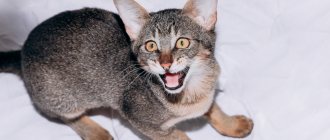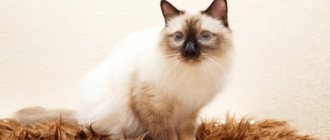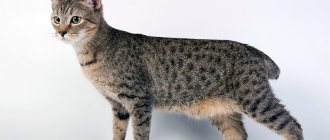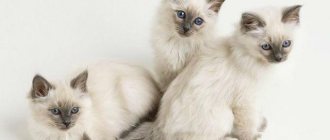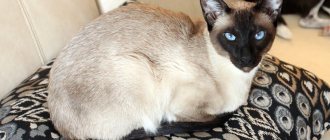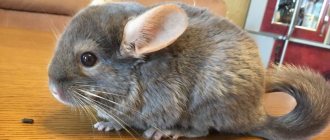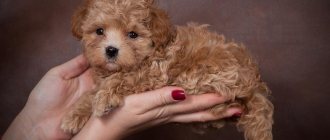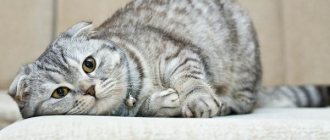The Burmese cat is one of the most beautiful pets. Burmese cats are very colorful due to their amazing color and soft length of fur. Calm, obedient, sociable and inquisitive, Burmese cats have coexisted peacefully next to humans for centuries, showing their emotional affection.
Description of the Burmese cat breed
Popularity 57th place among 87 cat breeds
Lifespan:
14-16 years old
Height:
from 28 to 32 cm
Country of origin:
Myanmar
Average price:
30-40 thousand rubles
Weight:
from 4.5 to 8 kg
Latest articles Cat health
Ataxia in cats: what it is, how it manifests itself and is treated 01/23/2022 169 0 0
Cat health
Leukemia, or viral leukemia in cats 01/23/2022 151 0 0
Key facts
The official name of the breed is the Burmese cat, or sacred Burma. The name is based on the country of origin - a state in Southeast Asia called Myanmar. Burma is its former name, popular among foreigners and lasting until 1989. In English pronunciation this word sounds like “Burma”, which often misleads people. The Burmese and Burmese cat breeds do share a common country of origin, but have completely different appearances. The description of the Burmese cat includes having long hair and a color-point coat, while the Burmese's coat is short and darker.
The average lifespan of a Burmese cat is 15 years. She has good health and a balanced character. The greatest friendliness is characteristic of males. They quickly find a common language with other animals, enjoy playing with children and are not afraid of strangers.
Among the key characteristics of the Burmese cat breed, it is important to note extreme curiosity and perseverance. These animals know how to achieve their desires, so sometimes they are too annoying.
One of the most famous Burmas is the Choupette cat, which belonged to the German fashion designer Karl Lagerfeld. After the owner's death, she inherited $200 million.
Nurseries
In Russia, the Burmese cat breed is widespread and it is not difficult to find a cattery with a high rating. There are several breeders of sacred Burma in Moscow:
- Adoration. The owners are strict about selling kittens, not handing them over to inexperienced amateurs for breeding.
- TARNIS*RU. Burmese kittens of various shades of color point are bred here.
- Nyan House. The nursery provides a large selection of animals that come from champion Burmese.
- Astra Venetum.
In addition, Burmese kittens can be found in Tyumen, Khabarovsk, Nizhny Novgorod, Rostov-on-Don and other large cities in Russia. Due to the characteristics of the breed, the characteristics of the animals do not depend on the region, so a beautiful cat can be bought at any nursery.
History of the origin of the Burmese cat
The exact country of origin of the breed is unknown, since the Burmese received its first official recognition in France in 1925. Felinologists suggest that the animals were brought from Myanmar by an American billionaire who took a cruise to eastern countries in 1919.
The man gave a considerable part of his fortune for two kittens, but only the girl survived the journey. It was she who became the founder of the European line. In the second half of the 20th century, furry animals were recognized by all felinological organizations.
It is believed that the appearance of the cats was achieved through matings of Siamese and Persians. Residents of Myanmar claim that mentions of these cats date back to ancient times and contain many interesting facts. One of them explains why animals are called sacred.
At the temples of the goddess Tsun Huan Ce, the guide of souls in the afterlife, with the death of some monks, black and white cats with golden eyes appeared. Buddhists believed that these were messengers of the goddess who had arrived to protect the temple, and treated them with special respect. One day, during an attack by robbers, one of the cats named Singh came to the defense of the monks. His fur glowed with a golden glow and his eyes changed color to bright blue. This scared off the bandits and helped defend the temple.
Owner reviews
- Marina : We have two cats with amazingly different characters, which manifest themselves in everything: Sonya is active and loves to walk. Hearing the command, he immediately runs to put on the harness. Harlequin defiantly lies down on the sofa, making it clear that at her advanced age, decent cats do not walk on a leash. During the trip, Sonya shows maximum activity and curiosity: she runs around the cabin and loves to look out the window. Harlequin sleeps in the carrier until the end of the trip.
- Tonya : The kitten quickly settled into our home and immediately found several secluded places where he could relax and play. Everyone immediately fell in love with him for his activity, love of the game and affectionate disposition. Never scratches small children and calmly endures all their squeezing. He mastered the litter tray and scratching post right away, and later learned to walk on a harness.
- Manyasha : Cats of the Sacred Burma breed are a little more than completely beautiful. They are simply amazing. Real kittens of this breed cost 600 euros. Yes, not a single breeder will give away a cat of this breed for free, because it is a real treasure. Burmas are difficult to breed. It is not surprising that professional breeders of this breed can be counted on one hand, and the requirements for the future owner are high.
What does a Burmese cat look like?
A photo of a Burmese cat shows an amazing resemblance to Siamese and Himalayans. This breed is suitable for those who are delighted with the Siamese color and Himalayan coat, but consider a thin body or flattened muzzle not beautiful enough. Along with its attractive appearance, a bonus to the Burmese is its docile and friendly character. The weight of these animals is 4-6 kg, and their height at the withers is about 30 cm. Boys are always larger than girls, so they usually weigh at least 5 kg.
Muzzle
The breed is characterized by a rounded head. Its width is slightly shorter than its length. The animal has a slightly convex forehead, rounded cheeks and a strong chin. According to the standards, 2 varieties of Burmese cats are allowed: with a pronounced stop for TICA and the absence of a transition from the muzzle to the “Roman” nose for FIFe. The calling card of the breed is its round, expressive sapphire-colored eyes. Their color varies from light blue to deep blue. Unlike other cats, blue eyes do not have a negative effect on hearing. The small ears are slightly tilted forward, rounded at the tips and pubescent on the inside.
Possible defects include squint, a different eye color, or the presence of a silvery sheen in them. An animal with such an appearance will be classified as a pet class and will not be allowed for breeding.
Body type
The head is located on a slightly muscular and wide neck. The body of the Burmese is squat and elongated, with powerful bones. The hind and forelimbs are thick and muscular. They end in round and strong paws with tufts of hairs between the toes. The raised tail is pubescent. Its knobbiness or curvature is unacceptable.
Coat and color
The animal's fur has no undercoat and resembles silk. On the belly, the hairs curl into a light wave, and on the neck they grow into a luxurious mane. The main color of the Burmese cat is color point. Unlike Siamese, the standard of this breed allows for all possible markings: chocolate, lilac, gray, red. The color of most of the coat varies from white to cream.
The dark markings present on the tail, ears, limbs and muzzle match the appearance of the Siamese. A distinctive feature of Burmese is considered to be white “socks” on all four paws. Their absence will result in disqualification. Defects also include points on the light parts of the coat and light marks on the points.
Coat color
The Burmese cat wears color point colors (translated into Russian as “colored dot”, “colored mark”). It is vaguely similar to the color of Siamese and Himalayan cats.
The main color of the fur is white, cream. The paws, muzzle and tail are highlighted in a contrasting color. White “gloves” are retained on all paws, which should be symmetrical on the front and hind paws. Paw pads are brown, dark brown, pink.
Interesting!
Breeders call this color multi-temperature. The recessive gene “CS” is involved in the formation of color. It is active in the coldest areas of the body. These are color points of a dark shade. The photographs perfectly convey temperature zoning.
Blue point
The blue Burmese cat is common and is considered a classic. The blue cat was the first of the breed. Her eyes are lighter compared to other representatives of the Burmese cat breed. The marks are highlighted in a cold, blue color with a gray tint. An excellent example is shown in the photo.
Interesting!
The Blue Burmese cat is very similar to the Thai breed, which is why they are often confused.
Dark brown point (seal point)
The color shown in the photo is considered a classic. The markings are dark brown or chocolate-colored to contrast with the light beige coat. The brown Burmese cat has deep dark blue eyes.
Lilac point
In many ways, the descriptions of the colors agree with each other. The only difference is the color of the points. In the lilac color, they are painted in a gray-purple hue. The nose is highlighted in a darker color, which is clearly visible in the photo. The lower parts of the limbs remain white.
Interesting!
An ancient legend says that special color marks appeared on the animal’s fur for a reason. This makes it easier for the patron goddess to protect her charges, even when she sees them from behind.
Chocolate point
The chocolate-colored Burmese cat has bright blue eyes, which even pictures convey. The tail is painted the same color as the “mask” on the muzzle, or highlighted with a shade of chocolate. The main coat color is milky, ivory. The paws are decorated with snow-white “gloves”.
Cream point
This Burmese cat has a white base coat. Let's say a cream shade or ivory color. The markings are highlighted with a creamy tint. Sometimes it blends in with the fur, as in the photo. The tail may be brighter.
Red point
The Burmese cat can even be red. The points are colored in a delicate carrot shade. The muzzle, ears, tail and paws stand out. The completion of the limbs remains perfectly white. Eye color is blue. The red-haired beauty rarely appears in a litter, so it is highly valued.
Tortie point
The points are tortoiseshell in color. 2-3 shades appear on the face, like the Burmese cat in the photo. There are spots of red, chocolate, and cream colors. Points on the paws can follow the palette. Less often they are painted the same color.
Tabby point
Distinguished by striped points. They can be red, gray, chocolate. The pattern is especially pronounced on the muzzle and paws. The ears and tail are highlighted in a dark shade. The nose may have a gray or pinkish color. Eyes remain blue from birth.
Interesting!
With the naked eye you can see the similarities between the Burmese and the Neva Masquerade breed. They have a characteristic Siamese coloration. However, the Neva Masquerade has green or gray eyes. Also, the Neva Masquerade breed is less patient and kind.
Personality of the Burmese cat
If we talk about who is suitable for Burma, then it will be the elderly and owners with disabilities. These animals don't like noise. Loud screams of small children or frequent parties frighten them, negatively affecting their psyche. This breed also has an intolerant attitude towards loneliness. They quickly become attached to their owners and enjoy sitting in their arms.
The character of the Burmese cat is called balanced. She is characterized by playfulness and high intelligence. Despite the increased activity, the animal always keeps itself within certain limits. A furry pet will never offend a child, so it can suffer if handled incorrectly. She gets along well with other pets, but can become jealous if she notices that a person is paying more attention to them. Burmese owners claim that their pets can read their thoughts. Initially, this feature was noticed by Buddhist monks, who nicknamed the animals “the eye of heaven” for their piercing gaze.
One of the disadvantages of the breed is excessive obsession. It manifests itself when an animal wants something very badly. Excessive assertiveness can even make you angry, but you have to put up with this behavior. Your negative reaction or lack thereof will only offend Burma. In most cases, manipulation skills are used appropriately when the owner is in a good mood.
Pros and cons of the breed
A description of the main characteristics will help you finally decide on the choice of breed.
Pros of Burmese cats:
- cleanliness;
- calm behavior;
- lack of aggression;
- positive attitude towards people, children, animals;
- easy care;
- elegant and expressive appearance, as confirmed by the pictures;
- empathy - animals quickly read the mood of the owner, support him if he is feeling bad, and rejoice with him;
- fast learner.
Disadvantages of the breed:
- are expensive;
- cannot be alone;
- can be overly curious and intrusive.
Despite the disadvantages, the pros always outweigh the choice of this lovely breed.
Raising a Burmese cat
Many owners do not understand how to stop their pets from scratching and chewing their hands. This problem often occurs due to improper training and games. The owner's hands are made for affection. They give food and should never hurt.
Also try not to use them for gaming. The exception is playing under a blanket. Most cats are convinced that they are hunting the “duvet monster” and not the owner.
When raising a Burmese cat, use punishment based on its character. The most effective method of punishment is ignoring. The main thing here is to make sure that the pet understands the reason for such treatment. If he went to the toilet past the tray while you were at work, then any punishment is already meaningless. In such a situation, the lack of affection will frighten the animal, which is detrimental to the psyche.
Another effective method of punishment is a stream of water. Use it when teaching prohibition commands. Burms are smart creatures. They will quickly realize the relationship and begin to stop their actions at the word “no”, without waiting for being sprayed with water.
Don't try to create a trained animal by doing the same thing as dogs. Your task is to correct behavior and get a well-mannered pet who is familiar with the basic prohibitions in your home.
Burma and children
Burmese kittens get along well with children, especially if the babies are raised together from diapers. You can leave your pet with your child without fear, knowing that it will not bite or release its claws.
Usually Burmese people patiently endure the not very skillful caresses of babies. First, you should still talk to the child, explaining that the cat is a living creature and you need to be careful with it.
Older children who love and know how to handle animals tend to find contact with Sacred Burma. Children and animals often become best friends and enjoy playing together.
Burmese cat health
Burms are long-lived cats. One of them, Lady Catalina from Australia, is immortalized on the pages of the Guinness Book of Records: her life expectancy was 35 years.
Thanks to careful selection, the health of the Burmese cat turned out to be quite strong. With regular visits to the veterinarian, timely treatment for parasites and the availability of all necessary vaccinations, Burmese live longer than other breeds.
Possible diseases
Hereditary diseases of Burmese include hypertrophic cardiomyopathy, corneal dermoids and vestibular disorders. If detected early, they are all treatable.
Heart problems are easily recognized by shortness of breath and coughing that appears immediately after active games. The presence of a dermoid (a sac-like tumor on the white of the eye) is visible to the naked eye. Coordination problems manifest themselves in unsteady gait and other balance problems.
Reproductive health
To obtain offspring, only purebred partners with pedigrees are used. Mating with other breeds, mestizos and representatives of the pet class is strictly prohibited. Due to the small number of representatives, felinological organizations strictly control all matings and can punish violators with a fine.
Pregnancy is a difficult test for the body. Frequent births, more than 3 times in 2 years, are prohibited. For Burmese cats, the conditions are less strict - they can mate twice a month.
Burmese are record holders not only in age, but also in the number of newborns. They usually give birth to up to 10 kittens, but one representative managed to give birth to as many as 19 babies. Coping with such a huge offspring is not so easy, so veterinarians recommend not torturing yourself or the animals. Immediately after the appearance of sexual activity, pets can be scheduled for sterilization or castration. For representatives of the pet class, this is the most reasonable solution, since they are not allowed for breeding.
Hereditary diseases
The characteristics of the Burmese cat are positive, partly due to thoughtful selection. There are common types of genetic disorders that can be treated.
Pathology of the vestibular apparatus
Cats have a naturally weak vestibular system. Therefore, pets are slow, a little clumsy and can fall over when jumping. They should not be forced to jump high or left near an open window or balcony.
Tendency to catch colds
Heat-loving animals easily get sick from drafts. It is necessary to create a comfortable climate for them at 23-25°C. If possible, floors are covered with carpets. Beds and cat blankets are placed on small hills.
Important!
Also, animals have a problem with the sinuses. The holes are quite tiny, which causes them problems when they have a cold.
Corneal dermoid
This is a thin, growing film on the cornea. It blocks the pet's view, depriving him of quality vision. The problem is solved surgically. Vision is completely restored.
Hypertrophic cardiomyopathy
This pathology is typical for many breeds. It is expressed in thickening of the walls of the ventricles of the heart. The organ pumps less blood, which provokes heart failure and blockage of blood vessels. There is only one treatment - surgery.
There is a list of simple symptoms that help identify the disease:
- apathy and lethargy of the animal;
- constant shortness of breath;
- low body temperature;
- weight loss;
- mucous membranes become bluish in color.
Important!
To track the disease in its infancy, cats are given an ECG once a year.
Features of feeding and diet
The cost of keeping a Burmese is quite high, since it does not favor dry food and canned food. Natural feeding is often more expensive, since in addition to food you have to buy vitamins. It is also worth considering the fastidiousness of the animal. Before you understand what to feed your pet, you will have to sweat in trying to recognize his favorite dish.
Of course, there are advantages to owning a Burma. She never suffers from obesity, because she knows her norm. Purebred pets will not eat everything that is poured into a bowl if the feeling of fullness has already set in. When preparing your diet, follow the general recommendations:
- Choose lean meats: chicken, rabbit, turkey. Pork and lamb are harmful to the kidneys and liver. Protein should form the basis of the diet.
- Use natural fermented milk products. Milk can only be given to kittens. After 1 year of age, all adult animals develop lactose intolerance.
- Supplement your main diet with a small amount of cereals and vegetables.
- Avoid any products that contain natural or artificial colors. They can change the color of the fur coat to a darker shade.
Feed adult pets twice a day, leaving no more than 250 g of food at one time, and even less dry food. It is enough for kittens to give 150 g of food 4-5 times a day. Calculating portions is necessary to ensure that the food does not spoil in the bowl. Remember that natural products are removed immediately after feeding.
Castration and sterilization
Puberty in cats begins at the age of 7-8 months. If the owner does not plan to breed them, they are castrated or sterilized at the age of 7-10 months. Consider how old the animal is. At the age of 3-5 years, the operation is not so easy to tolerate.
The operation takes no more than 15 minutes. Within a couple of hours the pet comes to its senses. Recovery takes about 2-3 days. Spayed and neutered animals live longer and experience less stress.
If you skip this step, the pet will suffer from the inability to perform reproductive functions. He will begin to mark his territory and ignore the litter box.
Care and maintenance
The birthplace of Burma is one of the hottest countries. When purchasing a representative of this breed, please note that temperatures below 20°C are unacceptable for him. The fluffy pet easily catches colds in drafts and prefers to sleep under a blanket even in summer.
Caring for and maintaining a Burmese cat involves creating comfortable and safe conditions. The animal must not be taken outside, kept in a pen or small cage, or deprived of human contact.
The Burmese are afraid of precipitation, and winter is the most dangerous time of the year for them. Also, future owners should keep in mind the special property of the vestibular apparatus of these cats. Landing on four paws is impossible for them. If an animal falls out of a window from the second or even the first floor, it can be seriously injured, so installing an anti-cat device is a prerequisite.
If you are often away from home, then be sure to take care of interactive toys. Intellectual games are especially loved by this breed and help distract them in lonely hours. Although a more adequate option would be to buy another pet.
For the health and hygiene of your furry pet, follow these recommendations:
- Brush it twice a week with a sparse comb. Due to the absence of undercoat, shedding in long-haired pets is weakly expressed, but the frequency of brushing during this period still needs to be increased.
- Clean your ears twice a month to remove dirt and wax from your ears and remove any discharge that accumulates in the corners of your eyes daily. Also, do not forget about monthly brushing of your teeth, which prevents the development of oral pathologies.
- Carry out washing only when heavily soiled, trying to accustom the animal to this procedure from early childhood.
- Trim the nails as they grow if the scratching post does not cope with this task.
Another important need for caring for your Burmese is keeping it clean. An animal may refuse to eat from dirty feeders or go to a tray with stale litter.
How to cope with loneliness
The Sacred Burma is a very social animal and does not tolerate loneliness well. Past life experience is of great importance to her. A kitten raised in a large family will constantly need affection and extra attention.
It is very good if one of the household members is always at home. In this case, the pet will not be deprived of attention. If adults and children go about their business every morning, leaving the Burmese alone to while away the time in the apartment, he may feel lonely. In the evening, you need to reward the sufferer by giving him maximum attention and participation.
It is highly not recommended to leave Sacred Burma alone for a long time. Being isolated and separated from its beloved owner, the pet will experience severe psychological discomfort, which can develop into depression.
Tips for choosing a kitten
One of the peculiarities of Burmese kittens is the absence of a characteristic color until a certain age. Babies are born completely white. The first marks appear only at 1-2 months of life, which is actively used by scammers. You will be able to find out the exact color of your future pet only after 1.5 years.
For safety reasons, choose a certified nursery that is ready to provide a mandatory set of documents for each of the wards. The price for such animals is higher than in advertisements on free boards on the Internet. But they are guaranteed to be healthy, meet the standard, and are even trained to use a tray or scratching post.
How to choose a kitten, its cost
In order not to run into scammers, it is better to buy a Burmese as a cat from a specialized cattery. It is important not to confuse it with the Burmese, this is a completely different breed. A similar name often causes confusion in the purchase history.
Characteristics of a healthy kitten:
- no discharge from the nose or eyes;
- clean ears;
- clear and conscious view;
- interest in the environment;
- clean thick fur;
- You need to remember that healthy kittens are extremely active.
You need to ask the breeder for a vaccination passport, a package of documents that includes a pedigree, and possibly studies confirming the health of the pet. It’s worth asking what kind of filler and food the kitten is used to.
Important!
At 3 months the kitten should have its first vaccinations. The breeder must train him to use the litter tray.
Inspection of the kitten's parents is mandatory. Their characteristics must be satisfactory. Aggression from animals is not allowed.
It is better for buyers to find out in advance how much a show-class, breed-class and pet-class kitten costs. The appearance and price of such kittens vary greatly.
If a kitten can participate in exhibitions and breeding and has a full package of documents, then its cost varies from 40 to 80 thousand rubles.
If the pet does not have documents, has minor defects or disadvantages, then it can be purchased much cheaper - for 10-25 thousand rubles.
Interesting!
Initially, the Burmese cat gives birth to kittens with light fur. After a few weeks, a brown mask and markings on the paws become visible. Full color is formed by 1.5 years. With age, the coat becomes darker and darker.
Pictures of kittens well convey their color in the first weeks of life.
How much does a Burmese cat cost?
Nurseries engaged in breeding in Russia are very rare. This affects the cost, reaching over 100 thousand rubles for show-class representatives. The price of a breed-class Burmese cat starts from 40 thousand rubles, and representatives of the pet class can be purchased for 25 thousand rubles.
It is better not to contact sellers with better offers. For that kind of money you can get a mixed breed or an animal without a pedigree, born as a result of an unplanned mating.
Do you like the article? 0
Coat
The fur of Burmese cats is fluffy and quite long. At the same time, it is very soft, silky, and easy to care for, since tangles do not appear in it.
Around the neck, the fur is much longer and more luxuriant, forming a so-called “jabot”.
In the belly area the coat is slightly wavy. The tail is very fluffy, the hair towards the end of the tail is longer than at its beginning.
On the face, the hair, like that of all cats, is very short, but closer to the body it becomes more luxuriant.
